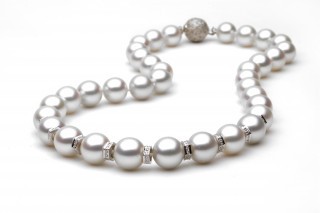
You may have read about pearl treatments before, you may have heard some of the negative connotations that people have when talking about these type of treatments. The truth is that all pearls are treated, you would not want a pearl that comes straight from the shell. Those pearls would not look the way that we have become accustomed to. In order to clear up some confusion, we are going to detail some of the pearl treatments, explain why these standard treatments are used, and tell you what you should be aware of.
Defining pearl treatments
We are going to define pearl treatments as anything other than polishing the pearl. These pearl treatments alter the overall appearance of the pearl and may include working, cutting, drilling, waxing, filling, heating, bleaching, and irradiation.
Treatments after harvesting the pearl
Again, once someone harvests these pearls, there is always some form of processing that occurs. Freshwater and Akoya pearls routinely receive some bleaching. All of the pearls that you see are polished and cleaned before they are put on sale. However, some treatments for cultured pearls are going to influence the aesthetic qualities of the pearl itself.
The high-quality cultured pearls are almost ready to go after they are polished and cleaned. However, a low-quality cultured pearl may still not have the desired luster. This means that the pearl farmer has a number of different options. They are able to sell the pearl at a heavy discount (meaning they make less money), peel the nacre off the pearl, and then try to sell it, or change the appearance of the pearl by applying a treatment. If the pearl does not have many other flaws, the treatment option is the most economically sensible and will be the common approach for a pearl farmer.
Most low-quality pearls undergo three main treatments. These include:
- Luster treatment – A way to enhance the luster artificially. The pearl is first heated and then cooled again. Alternatively, it could mean a coating treatment on the pearl surface
- Irradiation – This refers to using gamma rays to darken the nacre layers in freshwater pearls and the nucleus in Akoya pearls
- Dyeing – The pearl farmer uses an organic dye such as silver nitrate to darken the pearl nacre using a coating as treatment. This practice is greatly frowned upon and not widely practiced. This is the equivalent of applying some clear nail polish on the pearl. Even though the luster is initially going to look fine, that artificial coat may eventually start to peel or chip away. This shows the low-luster pearl right underneath the surface. Even though unscrupulous pearl dealers have tried selling these to unsuspecting consumers before, it remains rare to see this happen.
The use of irradiation
Irradiation has differing effects on saltwater and freshwater cultured pearls. In saltwater cultured pearls, the gamma rays do not influence the nacre layers. Instead, the pearl nucleus becomes a lot darker. If you have a saltwater pearl that has been irradiated, it is going to look blue or gray.
The freshwater pearl nacre is affected by gamma rays. This could lead to the nacre becoming very dark. . If you have a freshwater pearl that has been irradiated, it may have an iridescent orient and intense metallic sheen over its surface.
The use of silver nitrate
In order to darken the appearance of pearls, pearl farmers have used silver nitrate for decades. This chemical is going to enter into the nacre layers. Once there, this substance is going to have a chemical reaction with hydrogen sulfide gas and light in order to produce a richer, black color. If the pearl farmer wants colors other than black, it is possible to use organic or inorganic dyes to produce some different variations. Especially in freshwater pearls, this is a very popular treatment. Because low-quality pearls are not worth as much, it gives these pearl farmers a chance to experiment with the results and come up with some interesting color combinations. In order to enhance a more desirable rose overtone, farmers will also routinely ‘pink’ Akoya pearls.
How can you detect pearl treatment?
Remember that almost all the pearls that you are going to find on the market today have received some form of treatment. One way to detect irradiated or dyed pearls is by checking the matching of the strand. Natural pearls are going to vary slightly in color from pearl to pearl. If you notice that you have a strand of pearls that is perfectly consistent in color, it may suggest that these pearls received some form of treatment.
How can you detect luster pearl treatments?
Unfortunately, these are far more difficult to spot. For most people the only way to check is by magnifying the suspected strand at least 50 times. A coated pearl will have a smooth, glass-like surface, which is quite different from the scaly nacre surface of an untreated pearl.

